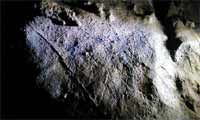Aveline's Hole Discovery

Two members of the University of Bristol Spelaeological Society have discovered an engraving in a cave in the Mendip Hills, Somerset, which may be at least 10,000 years old. Graham Mullan and Linda Wilson, who have spent much of the last ten years studying Palaeolithic cave art, recently began a systematic search of caves in southern Britain in the belief that such works in this country would not simply be confined to those found at Creswell Crags, Nottinghamshire.
The first results of this study are a series of inscribed crosses found on the wall of Aveline's Hole in Burrington Combe, Somerset. Aveline's Hole is famous as being the site of the earliest known cemetery in the British Isles. Recent work by Dr Rick Schulting and English Heritage shows that it was intensively used for burials shortly after the end of the last Ice Age, during the early Mesolithic period, and is this country's oldest known cemetery.
Abstract designs such as this are commonly found in Mesolithic settings. Some do, however, date back to the Upper Palaeolithic cultures of the last Ice Age and although Upper Palaeolithic peoples also used this cave, the discoverers, assisted by Bristol University rock art specialist, Dr George Nash, and experts from the British Museum, believe that this engraving is more likely to be post Ice Age in date.
Jill Cook, Deputy Keeper in the Department of Prehistory and Europe at the British Museum, said: "This is an exciting and important discovery. The few lines that form this panel are a signature from the period right at the end of the last Ice Age when the present period of warm climate was beginning. "The pattern is comparable with others known from Northern France, Germany and Denmark giving a wider context for the finds of this time and a rare glimpse of what may have been a rather special means of communication."
Graham Mullan and Linda Wilson are continuing their search and believe more works of this type may well come to light in the other caves in the area used by Early Man. A further engraving has been noted in one of the caves in the Cheddar Gorge, and further investigations are being carried out to verify this.
However, for the vast majority of engravings, it is impossible to obtain any direct dating evidence, leaving stylistic comparisons and archaeological context the only means of reaching a conclusion on the possible age of any such markings.
A gate has been installed in the cave to protect the engraving, after consultations between English Heritage and other interested parties, including the landowner and English Nature. Also note that no visits will be possible until bat hibernation season is over.
A full account of the discovery has been published in the Proceedings of The University of Bristol Spelaeological Society, volume 23 (2). This is available via the Sales Manager. You can also view the contents of vol. 23(2).
The Society was founded in 1919 in order to bring a scientific approach to the study of caves and their contents and one of its first projects was the excavation of Aveline's Hole, which continued throughout the 1920s.
Further Information
Please contact Graham Mullan, or read the article in the latest copy of Proceedings!
Related Links
BBC coverage
NBC coverage
These findings have also been reported in various papers.